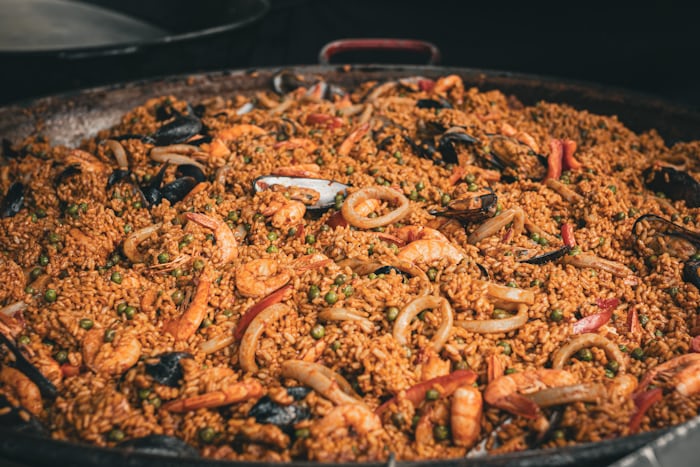If you are searching for a dish that embodies the essence of coastal Spain, then seafood paella is your go-to recipe.
This beloved Spanish classic is more than just a meal; it is a celebration of flavors, textures, and culinary tradition.
Even if you are a seasoned home cook or a beginner eager to impress, this guide will walk you through every step to create an authentic seafood paella that captures the heart of Mediterranean cuisine.
What Is Seafood Paella?
It was Originated from the Valencian region on Spain’s eastern coast, paella is a rice-based dish traditionally cooked over an open flame.
The name “paella” refers to the wide, shallow pan used to prepare it. While there are various regional versions, such as paella Valenciana (with chicken and rabbit) and paella mixta (a mix of meat and seafood), the seafood variant showcases the rich bounty of the Mediterranean Sea. The Key ingredients typically include:
- Short-grain rice (preferably Bomba or Calasparra)
- Saffron (for its distinctive color and aroma)
- Seafood (shrimp, mussels, clams, squid)
- Vegetables (tomatoes, bell peppers, peas)
- Olive oil, garlic, onion, and spices (like smoked paprika)
The magic of paella lies in its cooking technique, where the rice absorbs all the flavors, and the bottom layer forms a crispy crust known as socarrat, a highly prized feature.
Also Read on Paella vs. Jambalaya (Key differences)
Essential Ingredients for Seafood Paella
To cook an authentic seafood paella, sourcing the right ingredients is important. Here is what you will need:
Seafood Selection
- Shrimp: Opt for large, fresh shrimp with firm flesh and a mild, sweet scent.
- Mussels and Clams: Ensure they are tightly closed or close when tapped, indicating freshness.
- Squid: Cleaned and sliced into rings and tentacles.
Vegetables
- Onion: Finely diced.
- Bell Peppers: Red, green, and yellow, chopped.
- Tomatoes: Fresh and diced.
- Peas: Fresh or frozen.
Rice
- Bomba Rice: A short-grain variety from Spain, known for its ability to absorb flavors without becoming mushy. If unavailable, Calasparra rice is a good alternative.
Liquids
- Seafood Stock: Provides a rich base flavor.
- White Wine: Adds acidity and depth.
Seasonings
- Saffron: The hallmark of paella, giving it a golden hue and unique aroma.
- Smoked Paprika: Imparts a subtle smokiness.
- Rosemary: Freshly chopped for a fragrant touch.
Garnishes
- Lemon Wedges: For a zesty finish.
- Fresh Parsley: Chopped, to sprinkle on top before serving.
Step-by-Step Guide to Cooking Seafood Paella
1. Prepare the Sofrito
In a large paella pan or wide skillet, heat olive oil over medium heat. Add the diced onion and bell peppers, sautéing until softened. Incorporate the chopped tomatoes and cook until the mixture thickens into a rich, flavorful base.
2. Toast the Rice
Stir in the Bomba rice, ensuring each grain is coated with the sofrito. Allow it to toast lightly for a couple of minutes, enhancing its nutty flavor.
3. Add Liquids and Seasonings
Pour in the white wine and seafood stock, stirring in the saffron threads and smoked paprika. Bring the mixture to a simmer, allowing the rice to absorb the liquids.
4. Arrange the Seafood
Nestle the shrimp, mussels, clams, and squid into the rice. Do not stir after this point. Allow the seafood to cook and the rice to absorb the remaining liquid, which should take about 20-25 minutes.
5. Achieve the Socarrat
To develop the prized crispy bottom layer, increase the heat slightly during the final minutes of cooking. Listen for a gentle crackling sound, indicating the formation of the socarrat. Be cautious not to burn it.
6. Rest and Serve
Once the rice is tender and the seafood is cooked through, remove the pan from heat. Cover with a clean kitchen towel and let it rest for 5-10 minutes. Garnish with lemon wedges and chopped parsley before serving.
Tips for Perfecting Your Paella
- Use the Right Pan: A traditional paella pan ensures even cooking and the formation of socarrat. If unavailable, a large, wide skillet can suffice.
- Avoid Stirring After Adding Seafood: Stirring can release starches, making the rice creamy instead of achieving the desired texture.
- Monitor Heat Carefully: Even heat is essential for cooking the rice evenly and developing the socarrat without burning.
- Customize Ingredients: While seafood is traditional, feel free to add other ingredients like peas, beans, or artichokes for added flavor and texture.
Pairing Suggestions
Seafood paella pairs wonderfully with:
- White Wines: Albariño or a crisp Sauvignon Blanc complement the dish’s flavors.
- Light Beers: A pale ale or pilsner can balance the richness.
- Non-Alcoholic Options: Sparkling water with a slice of lemon or a citrusy mocktail.
Read Also on Easy Seafood Risotto Recipe
Frequently Asked Questions
1. Can I Use Frozen Seafood?
Yes, frozen seafood can be used, but ensure it’s properly thawed and drained to prevent excess moisture in the paella.
2. Is It Necessary to Use Saffron?
While saffron is traditional and imparts a unique flavor, you can substitute with turmeric for a similar color and mild taste.
3. How Do I Store Leftover Paella?
Cool the paella to room temperature, then refrigerate in an airtight container for up to 2 days. Reheat thoroughly before serving.

